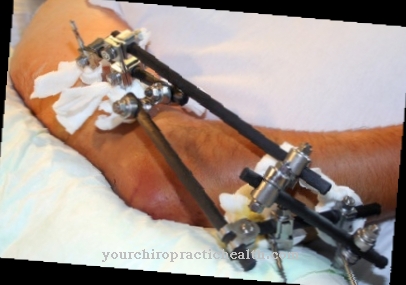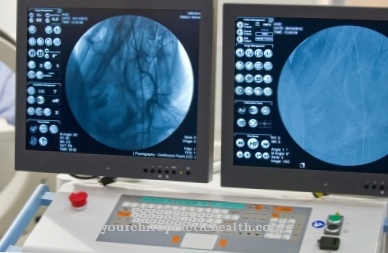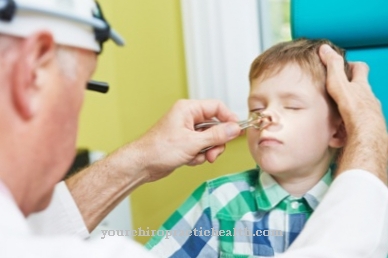At a Joint puncture the cavity of a joint is opened with a needle. It is used for introducing drugs or for aspirating liquids.
What is the joint puncture?

Joint puncture is a medical procedure in which the treating doctor pierces the joint capsule with a cannula. In this way, the doctor gains access to the joint cavity. The point of the joint puncture is the introduction of medical substances or the suction of fluid from the joint.
In principle it is possible to puncture all larger joints. The most common joint punctures include the knee joint, facet joint and hip joint puncture.
Function, effect & goals
A joint puncture can be used for both diagnostic and therapeutic purposes. It usually occurs when fluid builds up inside the joint. Doctors refer to such an accumulation of fluid as joint effusion. Joint effusions are usually caused by injuries or diseases of the affected joint.
This could be fresh meniscus damage or cartilage damage in the knee. Furthermore, diseases of the joint often occur due to rheumatism, infections or gout. A distinction is made between bloodless and bloody effusions. Mixing of synovial fluid and blood is possible. In contrast, a healthy joint is a viscous and clear puncture. The doctor is able to detect changes through a joint puncture. A more detailed analysis of the synovial fluid is carried out in a laboratory after the puncture.
When performing a joint puncture, a distinction must be made between diagnostic and therapeutic applications. A diagnostic puncture can determine the possible cause of joint effusion or swelling of the joint. In this way, the doctor determines whether there is inflammation or bleeding in the joint.
For example, traces of blood can indicate a capsule ligament injury or an injury with bone involvement. If the puncture is cloudy yellow, this is an indication of a rheumatic disease. In the case of a cloudy, thin consistency, there may be a purulent joint infection. If the synovial fluid is colorless, there is often damage to the cartilage or meniscus. If the liquid takes on a raspberry-red color, this indicates syphilis (syphilis).
The therapeutic joint puncture is also important. This is primarily used for pronounced joint effusions. With their help, pain can be quickly relieved and the joint relieved. The puncture is also extremely important if the patient suffers from a bruise in a joint. A larger amount of blood is then punctured, otherwise cartilage damage can occur, which in turn leads to painful inflammation within the joint.
In the case of an already existing joint inflammation, therapy with punctures alone does not make sense. The positive effect of the relief in this procedure is too short. For this reason, the doctor injects the patient with cortisone into the diseased joint. This procedure usually provides quick and effective pain relief. However, there must be no bacterial infection.
As part of the puncture, other drugs such as cartilage-building hyaluronic acid, painkillers or contrast media can also be injected. For example, a contrast agent is administered prior to computed tomography (CT) or magnetic resonance imaging (MRT). This gives the doctor the opportunity to better assess the joint.
When performing a joint puncture, it is important to ensure that it is sterile. The puncture should ideally take place in an operating theater area. Before performing the medical treatment, the joint to be treated is thoroughly disinfected. It is also provided with sterile towels for protection. The doctor wearing surgical protective clothing uses a split sheet to cover the puncture site. Cannulas are used that have different lengths and diameters as required.
In most cases, the patient will lie on their back during a joint puncture. The puncture is usually performed under ultrasound control. A cannula is inserted into the joint, through which the doctor either sucks off liquid or injects a drug.
Risks, side effects & dangers
Since hardly any pain is felt when performing a joint puncture, local anesthesia is only required in a few cases. You can usually do without general anesthesia. A longer stay in the hospital is also not necessary.
There is usually no need to fear major risks or complications with a joint puncture. In some patients, however, bleeding or damage to the joint structures is possible. Allergic reactions can also occur. This usually happens when the patient is given certain drugs during the puncture. Typical signs are a rash, itching and swelling. In the worst case, it can lead to a failure of the circulatory system or kidneys.
If sufficient sterility is not ensured, there is a risk of joint infection. In the case of a professional and sterile implementation, however, this risk is only minor. Impairments to blood vessels and nerves are also conceivable. There is also the possibility of mechanical damage to the joint from the penetrating cannula. Using the cannula can also cause bacteria to enter the joint, which in turn results in infection.
There are only a few known contraindications for joint puncture. It must not be carried out if skin injuries, skin diseases or an infection occur at the injection site. Another possible contraindication is a massive change in blood coagulation.
Typical & common joint diseases
- arthrosis
- Joint inflammation
- Joint pain
- Joint swelling
- Rheumatoid arthritis












.jpg)



.jpg)










.jpg)
